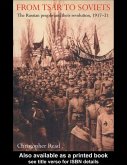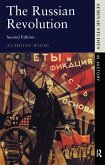Dieser Download kann aus rechtlichen Gründen nur mit Rechnungsadresse in A, B, BG, CY, CZ, D, DK, EW, E, FIN, F, GR, HR, H, IRL, I, LT, L, LR, M, NL, PL, P, R, S, SLO, SK ausgeliefert werden.
"Why did the Russian revolution, a mass uprising for justice and democracy, end in a single Party dictatorship? This gripping tale of workers in revolution and retreat is essential reading for anyone interested in an answer. Pirani follows Russian workers as they seize power, fight for a democratic revolution, and lose to a Bolshevik Party bureaucracy intent on consolidating control. Using exciting new sources, Pirani takes us into the factories of Moscow to understand relations among activists, workers, bureaucrats, and a multiplicity of revolutionary parties."- Wendy Goldman, Carnegie Mellon University
'Even though Pirani has clear political preferences, they never compromise the soundness of his analysis. Replete with new and often compelling source material, this impressively researched book is a stimulating, nuanced, competent and very readable account of critical political struggles during this important period in Soviet history. Most significantly, it actually has the potential to enhance our understanding of their outcomes. It undoubtedly deserves a wide readership.' - Simon Ertz, Stanford University, in Europe-Asia Studies, May 2009.
'The greatest contribution ot this sophisticated and penetrating analysis of worker-party relations is, in my view, the extraordinarily detailed way that Pirani has reconstructed debates and events at the grass-roots level. He effectively puts the reader 'in the room' with rank-and-file communists, and - to an unprecedented extent - independent non-party worker and socialist activists, as they doggedly defended the revolution's democratic premise on the shopfloor and in the factory cell. Through skilful writing and his intimate knowledge of his sources, we get a good sense of the emotional energy and urgency with which some workers engaged in the political arena at this critical juncture.' - Page Herrlinger in the International Review of Social History, April 2009.
'Simon Pirani approaches his topic from a basically Marxist perspective and utilizes as criteria the concepts of participatory democracy and the historical role (in the Marxist sense) that workers seemed to have achieved during the 1917 revolutions. Those who fear that this approach will be too delimiting and open to bias can be reassured. Pirani skilfully navigates the straits of conflicting political convictions as he wields his above-mentioned dual criteria to reveal quite mercilessly how Communist Party leaders and elites imposed hierarchical, bureaucratic, and repressive structures on the workers and the soviets. Even those who do not share the author's enthusiasm for what October 1917 seemed to portend will hardly be disappointed in this incisively sketched portrait of the utter betrayal of 1917's promise.' - Michael Melancon, Auburn University, in the American Historical Review, February 2009.
'This study brings significant new insights to the subject and makes a very significant contribution to filling in the 'view from below' of the early stages of the regime's evolution towards a totalitarian dictatorship and of the coalescence of a bureaucratic elite. In particular, it provides a rare, concrete feel for the still vibrant, though increasingly stifled, political life among the various party and non-party oppositions, all of whom defended, albeit within varying limits, the democratic and egalitarian aspirations of the October Revolution.' - David Mandel in Critique, May 2009.
'Pirani adds significantly to our understanding of high Party politics, including Lenin's conflicts with inner-Party oppositionists, the 1920 trade union debate, the Tenth Party Congress' ban on factions, and the 1923 contest between Stalin's triumvirate and the oppositionists associated with Trotsky. The heart of the book, though, are his case studies of trade union, soviet and Party organizations in Moscow, and particularly his examinations of nonparty factory workers' protests and strikes. Pirani devotes attention to the city's Bauman District cell and soviet; the Moscow Automobile Company (AMO) factory; the Bogatyr/Krasnyi Bogatyr rubber factory; the Bromlei/Krasnyi Proletarii machine building and engine factory; and the Trekhgornaia cotton textile factory. Pirani uses these to recast and revise a story otherwise familiar in its outlines from an array of previous studies. Among the studies to which his volume invites immediate comparison are Jonathan Aves's Workers against Lenin and Robert V. Daniels's The Conscience of the Revolution.' - Michael Hickey, Bloomsburg University, h-Russia, April 2009. Read the full review here
'Pirani has assembled a picture not of just what Trotsky said here or Lenin there, if you like the grand theory, but rather what lesser figures, people with more concern, perhaps, for what they'd understood the revolution to have been and how it should be defended. What we get here, then, includes the unnamed hecklers, the calls from the back, reported dutifully by those Cheka agents. The evidence he assembles is confined by choice specifically to the period 1920-1924. It is an interesting choice, for in this period we are leaving behind the distortions imposed by civil war.' - William Dixon in Mute. Read the full review here
'According to [...] Simon Pirani, although certain aspects of Bolshevik ideology âEUR played a crucial part in weakening and undermining the revolution, that ideology itself was powerfully impacted by social changes over which it [the Bolshevik government] had little control, and to whose operation it often blinded itself.' [...] The richness of detail and originality of Pirani's research is remarkable.' - Samuel Farber (author of Before Stalinism), in Against the Current. Read the full review here
'Pirani's book should be read by those who think, or who want to refute, that the state in Russia under the Bolsheviks could ever have been described as 'workers'.' - Adam Buick in Socialist Standard. Read the full review here
'Pirani sets out to show how little power ordinary workers had in the period 1920-24, over their workplace and over the Soviet Union in general. [...] He is the only person on the libertarian left who has set out to prove the point using original materials. Pirani is concerned to show that there were real workers and so a real working class in this period, and not a shadow class.' - Hillel Ticktin (author of The Ideas of Leon Trotsky, Origins of the Crisis in the USSR etc), in the Weekly Worker. Read the full review here and a response by Geoff Barr here
'It is difficult to convey in a short review how valuable is the new material that Pirani presents in this compelling study [...] including contemporary reports, speeches, articles and interventions by dozens of Bolshevik and non-Bolshevik workplace activists, factory managers, dissidents and bureaucrats - culled from minutes of various soviet, trade union and party meetings, from newspapers of the time, as well as from detailed reports of the Cheka, not to mention a considerable body of Russian-language post-Soviet scholarship.' - Paul Le Blanc (author of A Short History of the US Working Class, etc) in New Politics.
'This important volume fully warrants the appreciations offered in the front matter]...[Pirani writes well and situates his arguments nicely in the literature. Although studies of labour and politics, like Pirani's revolution, are also 'in retreat', this stimulating volume deserves a wide readership.]...[this impressive study will certainly engender, it should also stimulate new discussion.' -William G. Rosenberg, University of Michigan, Ann Arbor, Revolutionary Russia, August 2009
'Pirani's well-researched, sophisticated monograph is a welcome addition to the historiography of the Russian Revolution and Soviet working class. It is also a reminder that research on the Russian Revolution, even as we approach its centennial, has not been exhausted. The Russian Revolution in Retreat, 1920-24 is recommended reading for all Soviet scholars.' - Nicholas Ganson, College of the Holy Cross, Worcester, MA, USA; The Soviet and Post-Soviet Review 38 (2011)









